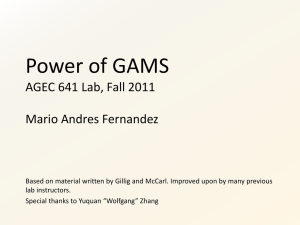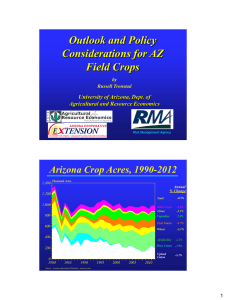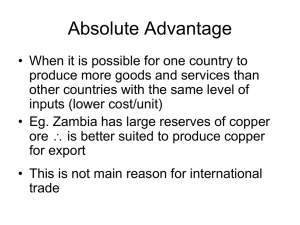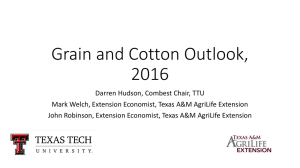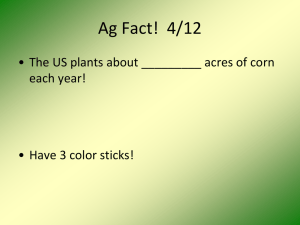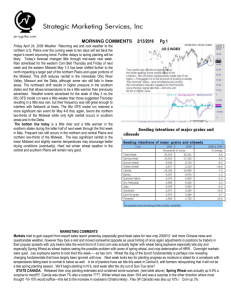Chapter 8 - Weber State University
advertisement
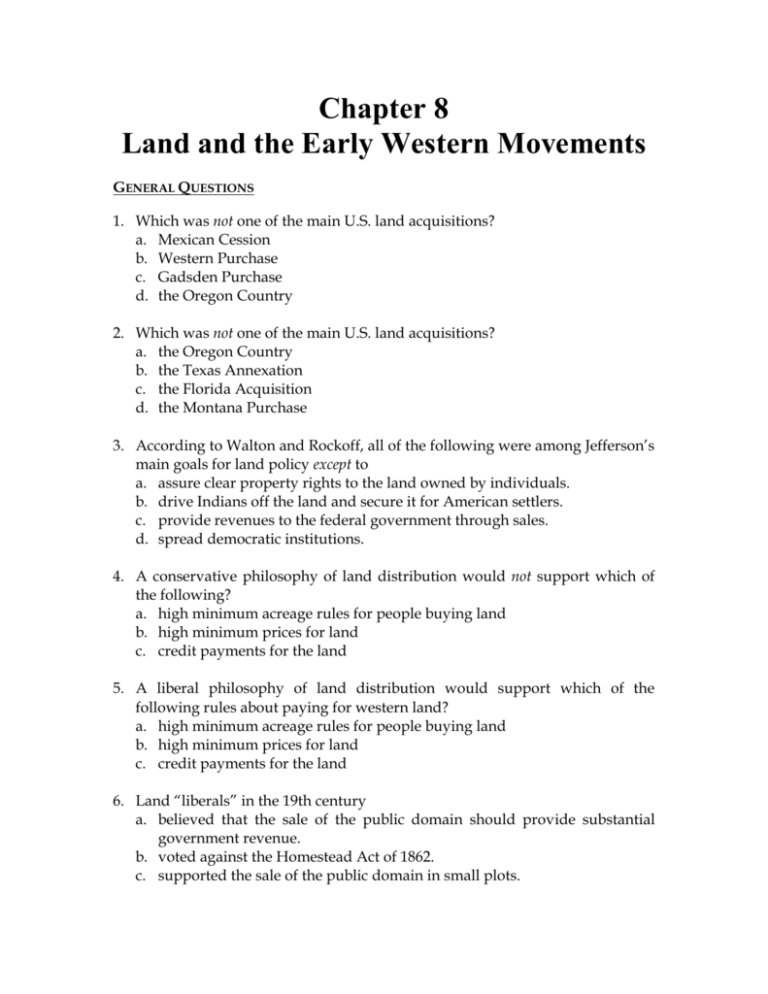
Chapter 8 Land and the Early Western Movements GENERAL QUESTIONS 1. Which was not one of the main U.S. land acquisitions? a. Mexican Cession b. Western Purchase c. Gadsden Purchase d. the Oregon Country 2. Which was not one of the main U.S. land acquisitions? a. the Oregon Country b. the Texas Annexation c. the Florida Acquisition d. the Montana Purchase 3. According to Walton and Rockoff, all of the following were among Jefferson’s main goals for land policy except to a. assure clear property rights to the land owned by individuals. b. drive Indians off the land and secure it for American settlers. c. provide revenues to the federal government through sales. d. spread democratic institutions. 4. A conservative philosophy of land distribution would not support which of the following? a. high minimum acreage rules for people buying land b. high minimum prices for land c. credit payments for the land 5. A liberal philosophy of land distribution would support which of the following rules about paying for western land? a. high minimum acreage rules for people buying land b. high minimum prices for land c. credit payments for the land 6. Land “liberals” in the 19th century a. believed that the sale of the public domain should provide substantial government revenue. b. voted against the Homestead Act of 1862. c. supported the sale of the public domain in small plots. d. were against the extension of credit to land buyers. 7. The Land Ordinances of 1785 and 1787 included provisions for all of the following except a. surveys prior to sale of Western land. b. profits from land sales to be redistributed to the public. c. guidelines for the eventual creation of Western states. d. sale of the land in plots of one square mile. 8. Which statement best describes the trend in land allocation laws from the Land Ordinance of 1785 to the Homestead Act of 1862? a. The changes were more favorable to those who held a conservative belief about land allocation. b. The changes were more favorable to those who held a liberal belief about land allocation. c. There was no consistent trend in the changes; some changes favored the conservatives and others favored the liberals. 9. Under the Graduation Act (1854), land prices for the public domain a. were subject to a schedule that reflected reduced prices for land that remained unsettled over time. b. were subject to a schedule that reflected reduced prices for native-born Americans and higher prices for immigrants. c. were increased to $1.25 per acre in cash. d. were increased to reflect inflation. 10. U.S. citizens migrating to Illinois in the first half of the 19th century would most likely have come a. from Massachusetts and New Jersey. b. from California and Oregon. c. from North and South Carolina. d. up the Mississippi River from Louisiana and Mississippi. 11. During the antebellum period, the “Old Northwest” became the leading producer of a. corn. b. wheat. c. hogs. d. all of the above. 12. Eli Whitney is most noted for a. inventing the steam engine. b. inventing the cotton gin. c. inventing the technology for the first railroad engine. d. developing the Erie Canal. 13. U.S. cotton production a. remained concentrated in Georgia and South Carolina until after 1860. b. was unable to compete with wool production in the antebellum textile industry. c. accounted for more than half of the dollar value of U.S. exports between 1800 and 1850. d. faced declining world demand for most of the antebellum period. 14. Large increases in agricultural productivity were not the primary reasons for migrating to which area of the nation during the antebellum period? a. Illinois and Wisconsin b. Indiana and Ohio c. the far west d. Texas and Mississippi 15. Which of the following was the most important factor determining the volume of land sales in the Midwest and South during the antebellum period? a. immigration b. Indian resistance to settlement c. agricultural prices d. governmental road building 16. What industry was the main economic impetus behind antebellum migration to the West Coast? a. fishing b. cattle c. fruit d. mining 17. What best describes Thomas Jefferson’s view of how American Indians should be treated? a. Tribes should be forced to leave their native lands in the east and move west. b. Indians should have full property rights that should be respected by whites. c. Indians could continue to live on their reservations but the federal government should have access to all mining and natural resources on their land. ECONOMIC INSIGHTS 1. The pace of settlement of the Old Northwest (Ohio, Indiana, Illinois, etc.) was determined primarily by the prices of a. soybeans, sorghum, and potatoes. b. gold and silver. c. corn, hogs, and wheat. d. cattle, leather, and cheese. 2. What would best characterize the relationship between corn prices, wheat prices, and the public sale of western land (OH, IL, IN, MI, IA, WI, MO) between 1815-1860? a. All three were very positively correlated. b. Land sales increased first, which drew people to move in and produce more crops, which increased the crop prices. c. As land sales increased, corn prices increased and wheat prices decreased as farmers substituted from wheat to corn. d. Land sales were negatively related to both the wheat and corn prices. 3. What best describes the westward movement of the population between 1800 and 1860? a. The largest number of people moved to the west during the 1850s. b. The large increase in sales during this period was based on speculation. c. Migrants moved to the west because they were “pushed” out of the east, where conditions were getting worse. d. Corn prices were relatively low in the decades when migration to the west was largest. ECONOMIC ANALYSIS 1. What would be the impact of a virus that infected the Midwestern corn crop? a. Price of corn increases, and the price of wheat decreases. b. Price of corn decreases, and the quantity of wheat increases. c. Quantities of corn and wheat increase. d. Quantity of corn decreases, and the price of wheat increases. 2. What best describes the impact of the cotton gin? a. a decrease in the price and an increase in the quantity of cotton b. an increase in the price and a decrease in the quantity of cotton c. decreases in both the price and quantity of cotton d. increases in both the price and quantity of cotton Return to Economics 1740 Announcement/Practice Exam Page


